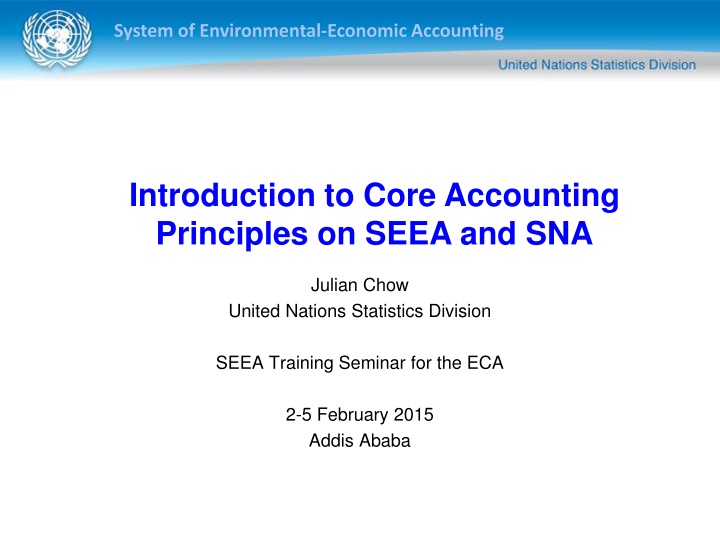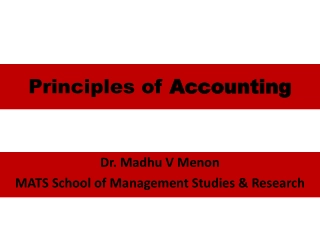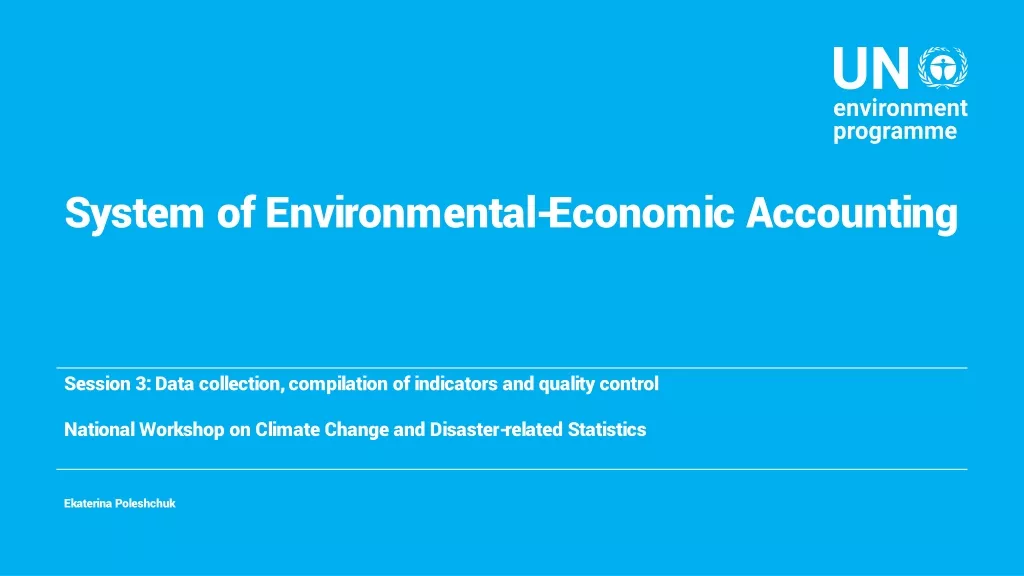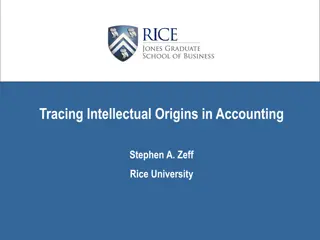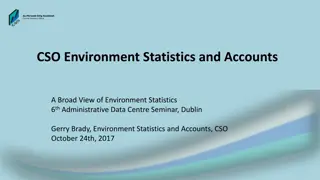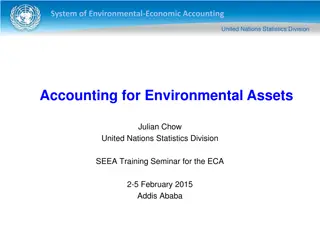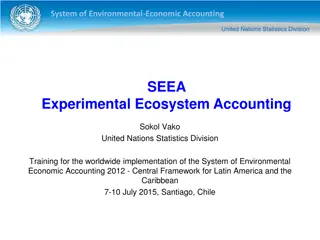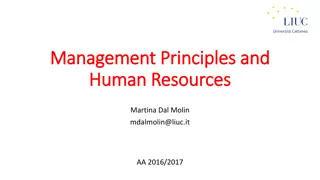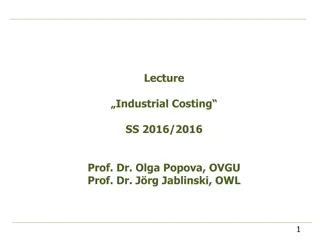Introduction to Environmental-Economic Accounting Principles
Fundamentals of national accounting, the scope of measurement, defining the economy and the environment, economic activities, assets, units, and territory. Delve into the constituents of a domestic economy and residence institutional units.
Download Presentation

Please find below an Image/Link to download the presentation.
The content on the website is provided AS IS for your information and personal use only. It may not be sold, licensed, or shared on other websites without obtaining consent from the author.If you encounter any issues during the download, it is possible that the publisher has removed the file from their server.
You are allowed to download the files provided on this website for personal or commercial use, subject to the condition that they are used lawfully. All files are the property of their respective owners.
The content on the website is provided AS IS for your information and personal use only. It may not be sold, licensed, or shared on other websites without obtaining consent from the author.
E N D
Presentation Transcript
System of Environmental-Economic Accounting Introduction to Core Accounting Principles on SEEA and SNA Julian Chow United Nations Statistics Division SEEA Training Seminar for the ECA 2-5 February 2015 Addis Ababa
System of Environmental-Economic Accounting Objectives of the Session Introduce and recall some fundamentals of national accounting Define the scope of measurement Defining the economy and the environment The production boundary Economic units sectors and industries Demonstrate the breadth of national accounting and the recording of stocks and flows SNA and SEEA as frameworks for organizing information
System of Environmental-Economic Accounting Defining the Economy
System of Environmental-Economic Accounting Defining the Economy Economic activities Production, Consumption, Accumulation Economic products Goods and services Economic assets Produced, Non-produced, Financial assets Economic units Establishments, enterprises, households, governments Economic territory Residence, geographic coverage
Domestic Economy Constituents of an Economy? All institutional units residing in the economic territory of a country during the accounting period constitute its economy.
System of Environmental-Economic Accounting Residence Institutional units Individuals Determined by Residence of the household of which they form part If not a quasi-corporate, same residence as their owners Normally the country of registration or where legally constituted. Branch in a different country quasi-corporate in the host economy Deemed always to have a centre of economic interest in the country where they are located. Thus, for all land & buildings are owned by non- residents a notional resident unit (with non- financial asset and direct investment liability) Unincorporated enterprises Corporations and NPIs (i) Owners of land, buildings & immovable structures (ii) extractors of sub- soil resources. 6
Some Questions Domestic Economy State whether TRUE of FALSE. 1. Foreign students staying for three years are considered residents. 2. A branch of Citi Bank (an American bank) in Tokyo is a resident of Japan. 3. Australian crew of a ship of a Japanese company are residents of Japan. Q 1. FALSE Q 2. TRUE Q 3. FALSE Q 4. TRUE 4. Non-residents are not considered to be owners of immovable assets. 5. All unincorporated businesses without separate accounts (i.e. households run businesses whose accounts are mixed in with those of household) belong to household sector 6. Branch of foreign NPI serving residents households is treated as a resident NPISH. 7. Central Bank is part of the general government sector. 8. A branch of a Japanese company in Thailand is resident of Thailand Q 5. TRUE Q 6. TRUE Q 7. FALSE Q 8. TRUE
Domestic Economy Institutional Sectors economy General government Household sector corporate NPISHs Financial corporate sector Non-financial corporate sector
System of Environmental-Economic Accounting Enterprises, Establishments and Industries Enterprises Institutional units from the perspective of being producers of goods and services Establishments Enterprises in a single location performing a single or predominant type of productive activity Industries Groupings of establishments undertaking similar types of productive activity
System of Environmental-Economic Accounting The Production Boundary Production is an activity carried out by an institutional unit that uses inputs of labour, capital and goods and services to produce outputs of goods and services (2008 SNA, 6.24) In practice: Exclude things you do only for yourself Exclude household production of services for itself Except rent of owner-occupiers & wages of domestic staff Include household production of goods for itself Agricultural products, fishing, fuelwood, clothes, furniture, water, energy Include concealed and illegal activity
System of Environmental-Economic Accounting Product Flows in the SEEA Environment Natural inputs (e.g. minerals, energy, timber, fish and water) Economy Mineral and energy resources Timber resources Fish resources Water resources Soil resources Land Enterprises Households Government Products Residuals (e.g. air emissions, solid waste, return flows of water)
System of Environmental-Economic Accounting Types of Output and Production Market output Transactions between economic units at market prices Non-market output Not transacted at market prices (government education, health) Valued at cost of production Own-account production in SNA (within establishments) For own final consumption (e.g. subsistence agriculture) : INCLUDED For own final capital formation (e.g. building own house) : INCLUDED For own intermediate consumption : EXCLUDED (except ancillary activity)
System of Environmental-Economic Accounting Own accounting production recording in SNA and SEEA SNA recording is limited to the production of goods for own use i.e. exclude own intermediate consumption SEEA Record all own account and intra-establishment production and use of goods and services i.e. include own intermediate consumption Example Production of energy through the incineration of waste by an establishment for own intermediate consumption is recorded in SEEA but not in SNA
System of Environmental-Economic Accounting Key Messages Many aspects to defining the economy Measurement boundaries are important to understand Production boundary key determinant of the size of GDP Own- account activity needs special consideration Economic (institutional) units can be seen from two key perspectives Institutional sector: Similar economic behaviours / legal basis Industry: Similar productive activities
System of Environmental-Economic Accounting Defining Environmental Assets
System of Environmental-Economic Accounting Discussion: What Things Might be Considered Environmental Assets?
System of Environmental-Economic Accounting Definition of Environmental Assets Environmental assets are the naturally occurring living and non-living components of the Earth, together constituting the bio- physical environment, which may provide benefits to humanity 2012 SEEA Central Framework 2.17
System of Environmental-Economic Accounting One Environment : Two Perspectives Individual environmental assets / resources Ecosystems Timber Water Soil Fish Forests Lakes Agricultural areas
System of Environmental-Economic Accounting Scope of Individual Resources 1 1.1 1.2 1.3 1.4 1.5 2 3 4 4.1 4.2 5 5.1 5.2 6 7 7.1 7.2 7.3 Mineral and energy resources Oil resources Natural gas resources Coal and peat resources Non-metallic mineral resources (excluding coal and peat resources) Metallic mineral resources Land Soil resources Timber resources Cultivated timber resources Natural timber resources Aquatic resources Cultivated aquatic resources Natural aquatic resources Other biological resources (excluding timber resources and aquatic resources) Water resources Surface water Groundwater Soil water
System of Environmental-Economic Accounting Physical and Monetary Scope In principle, when accounting for environmental assets in physical terms include all environmental assets whether or not they have a monetary value All land in a country is included in physical land accounts Also timber resources, other biological resources, soil, inland water resources Mineral and energy resources scope is known deposits Aquatic resources scope is all resources within EEZ plus rights on high seas In practice limit to commercial stocks and subsistence
System of Environmental-Economic Accounting Key Points and Boundary Issues Distinct treatment of land Account for its provision of space / area not the resources that are within it Include natural and cultivated biological resources Oceans and atmosphere excluded Stocks of potential energy from renewable sources excluded E.g. solar, wind, tidal power Slight exception for hydropower
System of Environmental-Economic Accounting Ecosystem Assets Areas comprising combinations of individual resources (timber, soil, water, etc) but also having ecological processes and characteristics Aim to assess Condition of the ecosystem within an area (i.e. how is it functioning, quality of processes) Flow of ecosystem services to economic and human activity Ecosystem asset accounting measures environmental impact rather than environmental pressures
System of Environmental-Economic Accounting Economic and Environmental Assets ECONOMIC ASSETS Produced assets - Fixed assets & inventories ENVIRONMENTAL ASSETS Natural resources & land with no economic benefits (e.g. barren land, known mineral deposits without current economic value) - Cultivated biological resources Non-produced assets - Contracts, marketing assets, etc. - Natural resources & land Financial assets
System of Environmental-Economic Accounting Key Messages Environmental assets can be seen from two perspectives: individual resources & ecosystems Both natural and cultivated resources are included in scope Scope is generally broader in physical terms than in monetary terms Land is accounted for in terms of area/space
System of Environmental-Economic Accounting Exercise: Defining the scope of measurement
System of Environmental-Economic Accounting The Structure of Accounts
System of Environmental-Economic Accounting Sequence of Accounts Describes sequence of interconnected flow accounts linked to different types of economic activity taking place within a given period of time, together with balance sheets that record the values of the stocks of assets and liabilities held by institutional units or sectors at the beginning and end of the period Each flow relates to a particular kind of activity such as production, or the generation, distribution, redistribution or use of income
Sequence of Accounts Links between the Accounts Production Account GDP Income Accounts savings Capital Account (non-financial assets) Opening Balance Sheet Other Economic flows Closing Balance Sheet Net lending/borrowing Financial Account (financial assets/ liabilities)
System of Environmental-Economic Accounting Organization of Accounts Current accounts Left hand side Uses Right hand side Resources Accumulation accounts Left hand side Changes in assets Right hand side Changes in liabilities and net worth Balance sheets Left hand side Assets Right hand side Liabilities and net worth
System of Environmental-Economic Accounting Sequence of Accounts (cont.) Production account Resources Output Uses Intermediate consumption Consumption of fixed capital Balancing item Gross value added Net value added Generation of income account Resources Uses Balancing item Gross value added Compensation of employees Taxes less subsidies Gross operating surplus
System of Environmental-Economic Accounting Sequence of Accounts (cont.) Allocation, distribution and use of income Resources Uses Balancing items Gross operating surplus Compensation of employees Taxes less subsidies Property income receivable Current transfers receivable Property income payable Current transfers payable Final consumption expenditure Balance of primary income Gross disposable income Gross saving
System of Environmental-Economic Accounting Sequence of Accounts (cont.) Capital account Resources Uses Balancing item Gross saving Gross fixed capital formation Change in inventories Purchases of non- produced assets (incl. natural resources) Capital transfers payable Sales of non-produced assets (incl. natural resources) Capital transfers receivable Net lending
System of Environmental-Economic Accounting Sequence of Accounts (cont.) Asset account Opening stock Additions Reductions Closing stock Produced assets Gross Fixed Capital Formation Consumption of fixed capital Non-produced assets Natural growth Natural losses Extraction Discoveries Catastrophic losses Purchases of non- produced assets Sales of non- produced assets Financial assets and liabilities Financial transactions Financial transactions
Sequence of Accounts Links between the Accounts Production Account GDP Income Accounts savings Capital Account (non-financial assets) Opening Balance Sheet Other Economic flows Closing Balance Sheet Net lending/borrowing Financial Account (financial assets/ liabilities)
System of Environmental-Economic Accounts (SEEA) view Industries Final demand Assets Sectors Financial and produced assets, opening balance Natural resource assets, opening balance Natural resource assets, opening balance Industrial output of goods and services Industrial intermediate demand Gross fixed capital formation Final demand Commodities Environmental protection expenditures Environmental protection expenditures Capital expenditures for environmental protection Resource production by industries Resource production by households/gov t Resource use by industries Resource use by households/gov t Waste consumption by industries Waste consumption by households/gov t Wastes Waste output by industries Waste output by households/gov t Other changes in volume & holding gains/losses on financial & produced assets Changes in and holding gains/losses on natural resource assets Changes in natural resource assets Sectors Financial and produced assets, closing balance Natural resource assets, closing balance Natural resource assets, closing balance
System of Environmental-Economic Accounting Supply and Use Tables Matrices that record how supplies of different kinds of goods and services originate from domestic industries and imports and how those supplies are allocated between various intermediate or final uses, including exports Involve the compilation of a set of integrated production and generation of income accounts for industries by drawing upon detailed data from industrial censuses or surveys Provide an accounting framework within which the product flow method of compiling national accounts, whereby the total supplies and uses of individual types of goods and services have to be balanced with each other, can be systematically exploited
System of Environmental-Economic Accounting Accounting and balancing identities Supply and use identity Within the economy, the amount of a product supplied must also be used with the economy, most likely by a range of different economic units, or exported Total supply of natural inputs = Total use of natural inputs Total supply of products = Total use of products Total supply of residuals = Total use of residuals Input-output identity Over an accounting period, flows of materials into an economy must equal the flows of materials out of an economy plus any net additions to stock in the economy
System of Environmental-Economic Accounting Basic Supply and Use Table Industries Households Government Accumulation Rest of the world Total Supply table Products Use table Products Output Imports Total supply Intermediate consumption Household final consumption expenditure Government final consumption expenditure Gross capital formation (incl. changes in inventories) Exports Total use Value added
Supply table show the flows relating to the production, generation, and supply of natural inputs, products and residuals by different economic units by different economic units or the environment Supply table Production; Generation of residuals Accumulation Flows from the rest of the world Flows from the environment Total Production; Generation of residuals by industries (incl. household production on own account) - classified by ISIC Generation of residuals by households Industries - classified by ISIC Natural inputs A. Flows from the environment (incl. natural resource residuals) Total Supply of Natural Inputs (TSNI) Total Supply of Products (TSP) Total Supply of Residuals (TSR) Products C. Output (incl. sale of recycled and reused products) I1. Residuals generated by industry (incl. natural resource residuals) D. Imports of products L. Residuals received from rest of the world Residuals J. Residuals generated by household final consumption K1. Residuals from scrapping and demolition of produced K2. Emissions from controlled landfill sites M. Residuals recovered from the environment I2. Residuals generated following treatment Total supply Use table Intermediate consumption of products; Use of natural inputs; Collection of residuals Industries - classified by ISIC Final consumption* Accumulation Flows to the rest of the world Flows to the environment Total Households Industries - classified by ISIC Natural inputs B. Extraction of natural inputs B1. Extraction used in production B2. Natural resource residuals E. Intermediate consumption (incl. purchase of recycled and reused products) Total Use of Natural Inputs (TUNI) Products F. Household final consumption (incl. purchase of recycled and reused products) G. Gross Capital Formation (incl. fixed assets and inventories) H. Exports of products Total Use of Products (TUP) Residuals N. Collection and treatment of residuals (excl accumulation in controlled landfill sites) O. Accumulation of waste in controlled landfill sites P. Residuals sent to the rest of the word Q. Residual flows to the environment Total Use of Residuals (TUR) Q1. Direct from industry and households (incl. natural resource residuals & landfill emissions) Q2.Following treatment Total use Use table show the flows relating to the consumption and use of nature inputs, products and residual by different economic units or the environment
Connections between SUT and asset accounts Asset accounts (Physical and monetary terms) Industries Households Government Rest of the world Produced assets Environmental assets Opening stock Monetary supply and use table Product-supply Product-use Output Intermediate consumption Imports Exports Household final consumption expenditures Government final consumption expenditures Gross capital Physical supply and use table Natural inputs- supply Extracted natural resources Natural inputs- use Imports of natural resources Output Product- supply Product-use Imports Intermediate consumption Residuals generated by industry Household final consumption Residuals generated by household final consumption Exports Gross capital formation Residuals from scrapping and demolition of produced assets; Emissions from controlled landfills Accumulation of waste in controlled landfills Other changes in volume of assets (e.g. natural growth, discoveries, catastrophic losses) Revaluations Closing stock Residual- supply Residuals received from the rest of the world Residuals-use Collection & treatment of waste and other residuals Residuals sent to the rest of the world Residuals flowing to the environment*
System of Environmental-Economic Accounting Key Messages All economic stocks and flows can be organized and placed in context National accounting is not only output and intermediate consumption One account is not sufficient different questions require a focus on different accounts and balancing items The accounting system is complete and internally consistent
System of Environmental-Economic Accounting The SEEA Central Framework Accounts 1. Flow accounts: supply and use tables for products, natural inputs and residuals (e.g. waste, wastewater) generated by economic activities. physical (e.g. m2 of water) and/or monetary values (e.g. permits to access water, cost of wastewater treatment, etc.) 2. Stock accounts for environmental assets: natural resources and land physical (e.g. fish stocks and changes in stocks) and/or monetary values (e.g. value of natural capital, depletion) 3. Activity / purpose accounts that explicitly identify environmental transactions already existing in the SNA. e.g. Environmental Protection Expenditure (EPE) accounts, environmental taxes and subsidies 4. Combined physical and monetary accounts that bring together physical and monetary information for derivation indicators, including depletion adjusted aggregates
System of Environmental-Economic Accounting Physical flows accounts Physical flow accounts Topics covered (detailed definition) Full set of supply and use tables for materials All resources and materials (energy, water, air emissions, water emissions, solid waste) (CF 3.45) Supply and consumption of energy; air emissions, water emissions, and solid waste (CF 3.279) Supply (precipitation) and consumption of water (CF 3.186) Supply and consumption of energy (CF 3.140) Air emissions (CO2, pollutants) (CF 3.233) Economy-wide material flow accounts (MFA) Physical supply and use tables for water (PSUT water) Physical supply and use tables for energy (PSUT energy) Air emissions accounts Water emissions accounts Water emissions (CF 3.257) Waste accounts Solid wastes (CF 3.268) CF = Central Framework, white cover edition, refers to paragraph number
System of Environmental-Economic Accounting Asset accounts Asset accounts Topics covered (detailed definition) Mineral and energy resources Physical and monetary accounts for minerals and energy stocks (oil, natural gas, coal and peat, non-metallic minerals and metallic minerals) (CF 5.172) Land Physical and monetary accounts for land, land cover, land use and forest (CF 5.235) Soil resources Area and volume of soil resources (CF 5.318) Timber resources Physical and monetary accounts for timber resources (CF 5.343) Aquatic resources Physical and monetary accounts for fish, crustaceans, molluscs, shellfish and other aquatic organisms such as sponges and seaweed as well as aquatic mammals such as whales. (CF 5.393) (CO2, pollutants) (CF 3.233) Other biological resources Cultivated animals and plants including livestock, annual crops such as wheat and rice, and perennial crops such as rubber plantations, orchards and vineyards. (CF 5.462) Water resources Stock of water resources (CF 5.471)
System of Environmental-Economic Accounting Monetary flows accounts Monetary flow accountsTopics covered (detailed definition) Environmental protection expenditure accounts (EPEA) Output of EP services in economy and expenditures on EP goods and services by resident units (CF 4.45) Resource use and management accounts (RUMEA) Production, supply and use, expenditures on and financing of resource management (CF 4.121) Environmental goods and services sector (EGSS) Characteristics of all producers of products intended for environmental protection and resource management (CF 4.95) Environmentally related payments by government Environmental subsidies, social benefits to households, investment grants and other current and capital expenditures (CF 4.138) Environmentally related payments to government Environmental taxes (taxes on products, production and income; other current taxes and capital taxes) and other payments to government (rent, sales of some goods and services, some fines and penalties) (CF 4.149, CF 4.159) Permits and licenses to use environmental assets Permits to extract and harvest natural resources (CF 4.174) Emissions permits Permits for the use of the environment as a pollution sink (emissions permits) (CF 4.182) Costs related to termination of fixed assets Environmental consequences of disposing of fixed assets (nuclear power plants, oil rigs and other equipment, landfills, mines, etc.) (CF 4.194)
